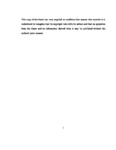Statistical inference about bivariate survival data with semi-competing risks using copulas
| dc.contributor.supervisor | Wei, Yinghui | |
| dc.contributor.author | Sorrell, Alexandra | |
| dc.contributor.other | School of Engineering, Computing and Mathematics | en_US |
| dc.date.accessioned | 2021-08-26T10:08:46Z | |
| dc.date.issued | 2021 | |
| dc.date.issued | 2021 | |
| dc.identifier | 10594690 | en_US |
| dc.identifier.uri | http://hdl.handle.net/10026.1/17734 | |
| dc.description.abstract |
Bivariate, semi-competing risk data are survival endpoints where a terminal event can censor a non-terminal event, but not vice versa. An example is the endpoints of graft failure and death; death can censor graft failure, but graft failure cannot censor death. There are potential correlations between these endpoints as they are measured on the same individual. Traditional methods of calculating correlations cannot be used directly as censoring can occur on one or both survival endpoints. We develop methods using a copula-based approach to study the dependence structures between two survival endpoints while the marginal distributions are fixed. We use several copulas to estimate the correlation between survival endpoints as each copula has a different dependence structure. We apply these methods to clinical examples in renal transplantation and HIV/AIDS. We include covariates to examine how the correlation and the hazard rates are associated with individual characteristics. The misspecification of both the copula function and the marginal survival distributions are investigated using simulation studies. Finally, we extend our methods to include individuals with incomplete survival outcomes. Our analysis indicates that the correlation between graft failure and death following transplant is affected by covariates. Our simulation studies conclude that the copula models with both the marginal distribution and the association parameters having a dependence on covariates provide improved estimates of the hazard ratios for the non-terminal event, compared to the Cox proportional hazards model. Simulation studies investigating misspeci cation find that the misspecification of both the survival distribution and copula function can increase the bias of the hazard ratios and correlation coeffcients. We use the AIC to choose between the survival distributions and copula functions. We found that the correct model is chosen in the majority of data sets at strong correlations. The presented copula models can be used to analyse bivariate, semi-competing risk data with a variety of univariate and multivariate structures. | en_US |
| dc.language.iso | en | |
| dc.publisher | University of Plymouth | |
| dc.rights | Attribution 3.0 United States | * |
| dc.rights.uri | http://creativecommons.org/licenses/by/3.0/us/ | * |
| dc.subject | Survival Analysis | en_US |
| dc.subject | Copulas | en_US |
| dc.subject | Renal Transplant | en_US |
| dc.subject | Regression Modelling | en_US |
| dc.subject | Correlation | en_US |
| dc.subject | Semi-comping Risk | en_US |
| dc.subject.classification | PhD | en_US |
| dc.title | Statistical inference about bivariate survival data with semi-competing risks using copulas | en_US |
| dc.type | Thesis | |
| plymouth.version | publishable | en_US |
| dc.identifier.doi | http://dx.doi.org/10.24382/421 | |
| dc.rights.embargodate | 2022-08-26T10:08:46Z | |
| dc.rights.embargoperiod | 12 months | en_US |
| dc.type.qualification | Doctorate | en_US |
| rioxxterms.version | NA |
Files in this item
This item appears in the following Collection(s)
-
01 Research Theses Main Collection
Research Theses Main



